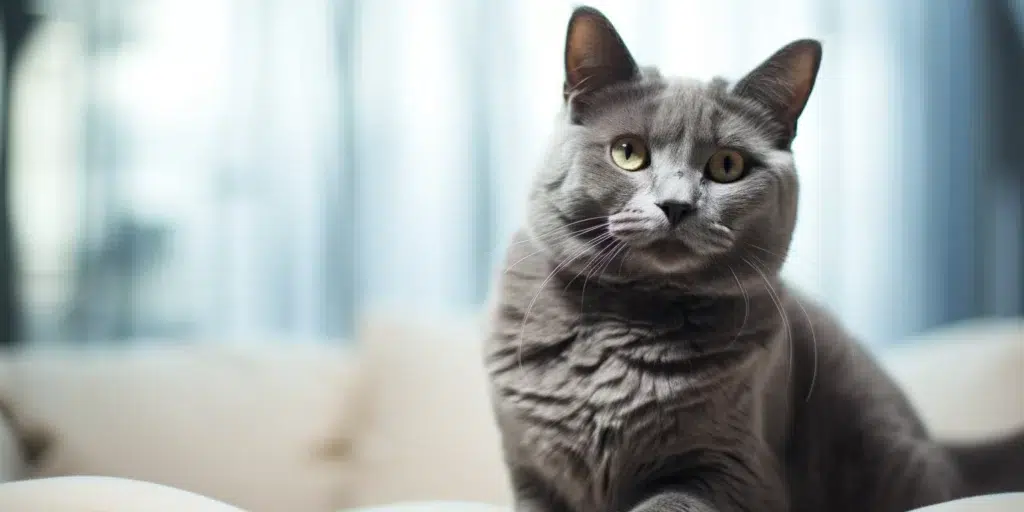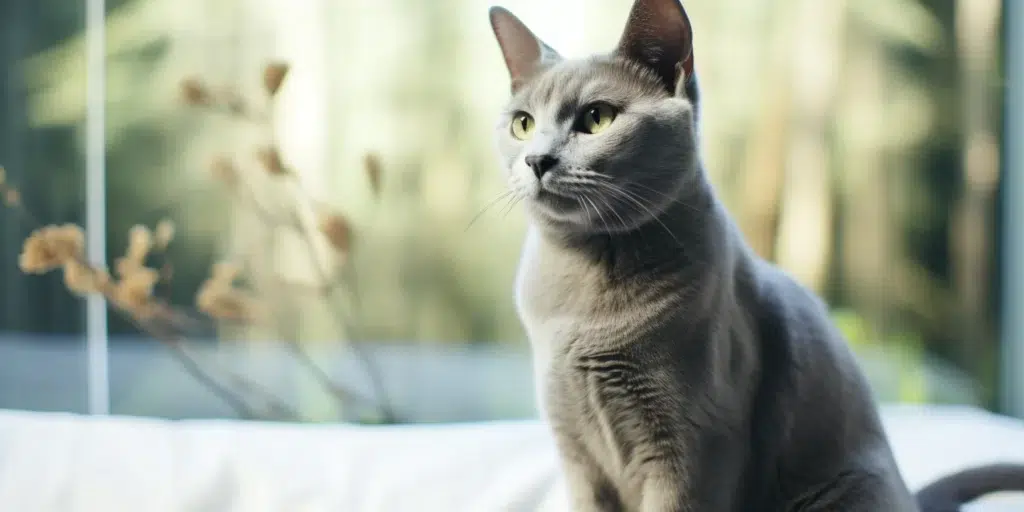When it comes to choosing a Russian Blue cat, one of the decisions pet owners grapple with is whether to opt for a male or a female. The Male vs Female Russian Blue distinction is important for potential cat owners who have specific preferences regarding their future feline companion’s behavior, physicality, and care needs.
Russian Blues are renowned for their striking appearance, gentle temperament, and intelligence, but subtle nuances between genders can make each a distinct experience. In this blog, we’ll delve deep into the world of the Russian Blue, examining all aspects of Male vs Female Russian Blues to aid you in making an informed decision.
As you embark on the journey of understanding the differences between Male vs Female Russian Blues, you’ll find that while they share an equally enchanting mystique, their characteristics can diverge in fascinating ways.
Acquainting oneself with these variations can greatly influence the harmony within a household and the overall bond between cat and owner. Whether you’re drawn towards a potentially more robust male or a possibly more elegant female, this blog promises an insightful exploration of both genders in this beloved cat breed.

Visual Differences
| Male Russian Blue | Female Russian Blue | |
|---|---|---|
| Average height (adult): | 10-12 inches | 8-10 inches |
| Average weight (adult): | 10-15 pounds | 7-12 pounds |
| Lifespan: | 15-19 years | 15-20 years |
| Exercise: | Moderate – Likes playful activity | Moderate – Enjoys interactive play |
| Grooming needs: | Low – Weekly brushing | Low – Weekly brushing |
| Family-friendly: | High – Affectionate and loyal | High – Affectionate and sometimes more nurturing |
| Other pet-friendly: | Varies – Can be social with proper introduction | Varies – Can be social but may be more cautious |
| Trainability: | High – Intelligent and eager to please | High – Smart and often responsive to training |
Male Breed Overview
Male Russian Blues are impressive creatures with a robust build and a dignified presence that often captures the hearts of cat lovers. Their serene demeanor is paired with a playful side that manifests itself through their love for interactive games. Tradition suggests that males are slightly larger in stature than their female counterparts, giving them a more majestic appearance that many owners find appealing.
In terms of personality, Male Russian Blues are known to be affectionate, forming strong bonds with their families. While inherently reserved, they show great loyalty to those they trust. Also, prospective owners will be intrigued by the male’s occasional bursts of energetic playtime which provide an excellent opportunity for bonding and ensuring the cat stays physically active. A unique feature of the breed is its coat color – a blue-grey hue that’s uniform throughout, which is particularly dense and plush with males.
Male Russian Blues are also praised for their intelligence, making them quite amenable to training. Their keenness to engage with their owners and their inquisitive nature often makes teaching easier, as they take pleasure in learning tricks or fetching toys. The thick, plush fur that characterizes the breed is stunning but also requires regular grooming, although males generally do not demand extensive maintenance outside of weekly brushing to keep their coats in good condition.
Training A Male
Training a Male Russian Blue can be an enjoyable experience due to their sharp intellect and curious nature. They respond well to positive reinforcement strategies such as treats and praise. Regular training sessions provide mental stimulation which is beneficial for their overall well-being. Teaching them to use scratching posts and litter boxes is typically straightforward, as cleanliness is instinctual for this breed.
Challenges might arise if training becomes too monotonous or predictable for the intelligent Male Russian Blue. To keep them engaged, vary the routines and incorporate interactive toys that challenge their problem-solving skills. Training should begin early when they are kittens to establish good habits and build a strong rapport between pet and owner.
Health & Care
Male Russian Blues boast robust health typically but like all breeds they have some predispositions towards certain health issues such as bladder stones and urinary tract diseases. A diet tailored to prevent these issues is recommended along with regular check-ups with a veterinarian. This breed’s thick coat should be brushed weekly to distribute natural oils and remove dead hairs, thus preventing hairballs.
Furthermore, despite their laid-back nature, they do require physical activity for maintaining a healthy weight. Providing plenty of opportunities for playtime and exploration helps in keeping them both physically and mentally fit.
Suitable for:
Males of this breed are suitable for various households. Their adaptable nature makes them good companions whether in a lively family setting or a single-person home. Due to their sociable disposition, they can thrive in environments with older children who understand how to interact gently with pets. They often do well with other animals too, especially if introduced slowly and correctly.
First-time cat owners will find the Male Russian Blue friendly and relatively easy to care for. However, they do best in quieter environments where the hustle and bustle are limited as they prefer routines and tranquil surroundings. Their need for interaction means they thrive best with owners who can dedicate time to bonding through play and cuddles.

Female Breed Overview
Female Russian Blues often possess a refined elegance that endears them to many cat enthusiasts. They tend to be slightly more petite than males which adds to their delicate allure. Females of this breed maintain much of the serene beauty that defines Russian Blues but may exhibit more independence compared to males.
Their nurturing instincts sometimes come forward especially around their human family members, displaying affection generously once they form a trusting bond. Just as intelligent as males, female Russian Blues are quick learners who can bring joy and entertainment into any home with their playful antics balanced by calm moments of contentment basking in attention or quietly observing their domain from a favored perch.
Female Russian Blues maintain the same silvery-blue coat that the breed is famed for; it can appear just as plush as that of males, though it might seem slightly less dense due to their smaller size. They carry themselves with poise and grace which is only amplified by their captivating green eyes that seem to hold an entire world within them.
Training A Female
Female Russian Blues can be just as responsive to training as males if approached correctly. They appreciate consistency and gentle encouragement, thriving on positive interactions that reinforce good behavior. Puzzle feeders can harness their intellect, providing entertainment while also rewarding them with treats for successful problem-solving.
The key to training females is understanding their independent streak; they may sometimes appear aloof or less interested in repetitive training exercises. To combat this, keeping training sessions short and sweet can help maintain their interest.
Starting socialization early on is vital too; as females tend to be cautious around new people or pets – introductions should be gradual and stress-free.

Health & Care
Health-wise Female Russian Blues share common traits with males in regards to potential hereditary conditions but are generally hardy cats. A balanced diet sensitive to her dietary needs is crucial throughout her life stages – particularly if she goes through pregnancy or nursing which may demand specific nutritional requirements.
Grooming is important but not overly taxing due to its low maintenance coat which benefits from regular brushing to minimize shedding and hairballs. It’s also worth noting that female hormones can affect behavior so spaying not only helps prevent unnecessary litters but may also stabilize mood fluctuations.
Suitable for:
Female Russian Blues fit well into various home settings much like their male counterparts but may sometimes integrate better into quieter homes where their independence can shine without being overshadowed by excessive noise or activity. They are wonderful companions for individuals or families who respect a cat’s space when she desires it while also providing affectionate interaction on her terms.
Owners who work during the day may find that females handle alone time well provided that they have plenty of stimuli such as window perches or toys to keep them engaged in the owner’s absence. Families with children should ensure kids understand how to interact respectfully without overwhelming the cat’s sensitivity.
Which One Is Right for You?
Choosing between a Male vs Female Russian Blue comes down to personal preference regarding what you seek in a pet’s temperament and your lifestyle needs. Males may offer more robust interaction with playful behaviors whilst females offer subtler companionship balanced with independent flair. Both genders share compatibility with family life and adaptability to different types of households including those with other pets when proper introductions are made.
Prospective owners need to decide what gender aligns best with the time they can commit; considering areas such as attention demands, playtime opportunities, grooming upkeep, and potential health risks which can be managed with due diligence. Reflecting on what Male vs Female attributes are most appealing or practical will help make a decision that fosters happiness both for your future pet and your family dynamic.

Conclusion
In conclusion, regarding the Male vs Female Russian Blue debate, it’s clear that both sexes offer unique qualities that are delightful in their ways. They each come with attributes that would endear them to any cat lover looking for an intelligent, loyal companion with a hint of royal grace.
Russian Blues regardless of gender require commitment from an owner in terms of time investment towards their health, grooming care needs, social interaction balance, and exercise provision alongside recognized similar lifespan potentialities which defines this elegant breed’s captivating essence.
Ultimately whether you find yourself leaning towards adopting a male or female will depend on individual considerations weighed against what each gender has to offer amidst shared breed qualities.